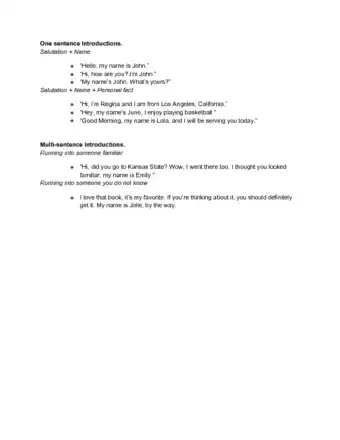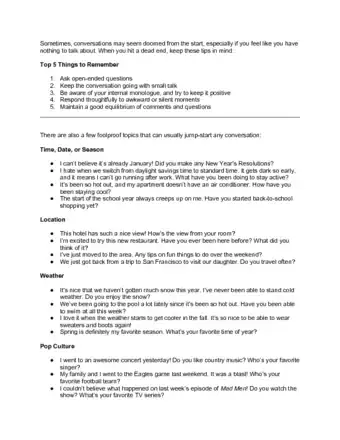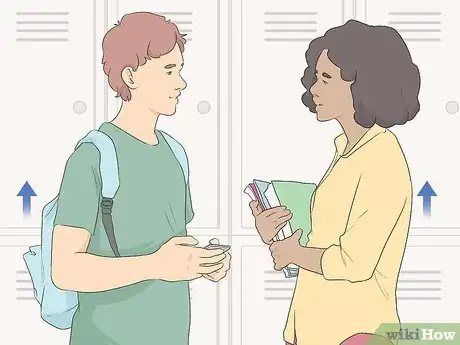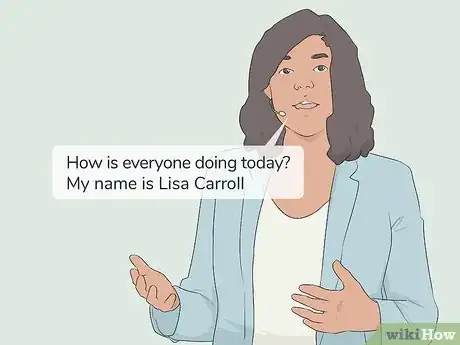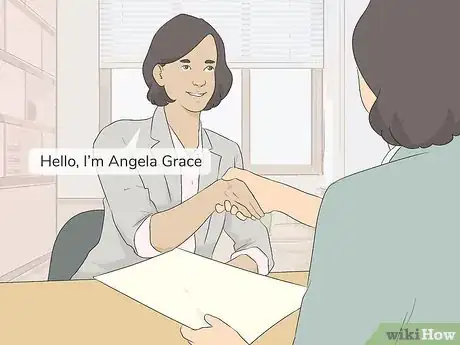This article was co-authored by Shannon O'Brien, MA, EdM. Shannon O'Brien is the Founder and Principal Advisor of Whole U. (a career and life strategy consultancy based in Boston, MA). Through advising, workshops and e-learning Whole U. empowers people to pursue their life's work and live a balanced, purposeful life. Shannon has been ranked as the #1 Career Coach and #1 Life Coach in Boston, MA by Yelp reviewers. She has been featured on Boston.com, Boldfacers, and the UR Business Network. She received a Master's of Technology, Innovation, & Education from Harvard University.
There are 19 references cited in this article, which can be found at the bottom of the page.
wikiHow marks an article as reader-approved once it receives enough positive feedback. This article has 44 testimonials from our readers, earning it our reader-approved status.
This article has been viewed 5,190,846 times.
If you’re confused or nervous about introducing yourself to others, you’re not alone! Whether you need to introduce yourself to a new team of colleagues or to a stranger at a party, introductions can feel uncomfortable or straight-up stressful. You can stop worrying about sweaty palms and awkward intros, because we’ve compiled a bunch of simple strategies to make introducing yourself easier. Get ready to make a great first impression!
Things You Should Know
- Introduce yourself to new acquaintances with a handshake and a smile. Then, offer your name and ask for theirs.
- If you're giving a speech, share your name and relevant credentials. Stepping out from behind the podium will make you seem more confident.
- At professional events, give your name along with a quick description of your work. Ask the other person a question about their work to establish a connection.
Steps
Introduction Help
Introduction Guidelines for Social Situations
-
1Make eye contact. When you catch someone’s eye, it shows that you're engaged in the interaction. It’s a way of signaling that you’re open and connected, and that they have your full attention.[1]
- If you're not comfortable looking straight into someone's eyes, stare at the point between their eyebrows instead. They won't notice the difference.
- If you’re in a group setting, make periodic eye contact with those around you.
-
2Share a genuine smile. A bright, sincere smile shows someone new that you’re happy to meet them. It’s also been shown that smiling people are perceived as more likable and friendly.[2] Moving your eyebrows upward while smiling creates a warmer expression that says you’re ready to share a positive experience with your new acquaintance.Advertisement
-
3Use open body language to show confidence and demonstrate interest. As you speak, lean in towards the other person slightly.[3] Stand with your head high and your back straight, being careful not to slouch. Displaying confident body language like this communicates that you’re at ease. Mirror the head tilt and pace of speech of the person you’re meeting to build rapport.[4]
Greeting an Individual
-
1Break the ice by exchanging names. If the introduction is formal, say "Hello, I'm [first name][last name]." If it's informal, just use your first name. Immediately after you've stated your name, ask for the other person's name by saying, "What’s your name?" in a pleasant tone.[5] Then repeat it by saying, "It's a pleasure to meet you, Pedro," or "It’s nice to meet you, Caroline."
- Repeating the person’s name will help you remember it and give the introduction a more personal touch.
- Some other ways to begin an introduction include, "Let me introduce myself, I'm [name]," and "Hi there, I'm [name]." Or, for a very casual greeting, try, "Hey, how's it going? I'm [name]."
-
2Offer a handshake or other culturally-appropriate greeting. Most cultures have a form of physical contact to accompany a greeting; in the United States, it is often a handshake.[6] Be sure to keep the handshake brief and not too loose (floppy) or firm (bone-breaking).
- It’s sometimes appropriate to greet someone with a hug, especially if you’re meeting the friend or relative of someone you’re close to. Hugs show more openness than a handshake. Women may be more likely to prefer a hug instead of a handshake.
- Be aware of cultural differences. For instance, it is considered rude to firmly shake hands in China. In some cultures, it’s common to greet others with a kiss. In South America, women are greeted with one kiss, while in France, women are greeted with one kiss on each cheek.[7] If you’re feeling uncertain about what to do, follow the other person’s lead.
-
3Ask questions to show interest in the other person. Inquire where they’re from, what they do for a living, or about their hobbies.[8] Show that you’re engaged by responding with follow-up questions. You can also share a little bit of your background, such as where you work or that you love rock climbing; that might lead to more conversation topics.
- Try asking an open-ended question like, "How did you get into cycling?" or "Oh, you've lived here for years; would you mind suggesting some local restaurants I should try?"
-
4Close the conversation. Wrap up the convo by saying you enjoyed meeting them. If the interaction was formal, say something like, "Mrs. Castro, I'm delighted to have met you. I hope we can talk again soon." If your conversation was informal, you can say "It was great meeting you, Harold. Hope to see you around."[9]
- Other ways to wrap up a convo: "I hate to run off, but I need to get going. It was nice talking to you." "Well, I won't take up any more of your time. Thanks for the chat!" "It was a pleasure talking with you. I'll be sure to check out that restaurant you mentioned."
Introducing Yourself in a Speech
-
1Greet the audience and state your name. Speak clearly and confidently while giving your first and last name. Say, "Good morning, I’m Chelle Arnold," or "How is everyone doing today? My name is Lisa Carroll.”[10]
-
2Share relevant information about yourself. Providing details about your career or expertise builds credibility with your audience.[11] The sort of information you share will depend on your audience and the subject you'll be talking about. For example, if you're giving a speech about the importance of eating organic foods, people will be interested to know if you're a scientist, chef, or environmental professional.
- Include any other relevant background experience. For instance, you might say, “My name is Eric Lafaurie and I am a professor of environmental science at Berkeley. After I conducted my research in the Amazon rainforest, I realized how important it is to share ways to protect our planet.”
- Make your purpose clear by saying something like, "Over the next 15 minutes, I'll walk you through..." or "Today, I'm going to explain...."
-
3Communicate clearly so people can understand you. Make sure your voice is loud enough for everyone to hear. It’s important to enunciate your words; even if you have a microphone, people won’t be able to understand you if you mumble.[12] Use a conversational tone and be aware of how quickly you’re speaking.[13]
-
4Use confident body language to enhance your message. Look self-assured by standing up tall with good posture. If you don't have to stand behind a podium, walk around to show the crowd how comfortable you are. Keep your hands free and use them to gesture when necessary. Your posture, facial expression, and gestures will capture the attention of your audience.[14]
Professional Introductions
-
1State your full name. Provide your first and last name while offering them your hand to shake. You can say, "Hi, my name is Mark Salazar," or "Hello, I'm Angela Grace.” Remember to smile and make eye contact.[15]
-
2Give a short description of what you do professionally. Include your job title, who you work with, and what you do. You might say, “I’m a professor of environmental science at Berkely, and I educate students about the impact of humans on natural ecosystems.[16]
- You could also say something like, "I'm a digital marketer, but really my job is about helping businesses connect with customers in an authentic way." Or, you might say, "I'm a geotechnical engineer, which is a fancy way of saying I make sure new highways won't disappear into sinkholes."
- If you’re at a job fair, include a sentence about your career goals. Add something like, “I’m interested in furthering my career at Stanford.”[17]
EXPERT TIPShannon O'Brien is the Founder and Principal Advisor of Whole U. (a career and life strategy consultancy based in Boston, MA). Through advising, workshops and e-learning Whole U. empowers people to pursue their life's work and live a balanced, purposeful life. Shannon has been ranked as the #1 Career Coach and #1 Life Coach in Boston, MA by Yelp reviewers. She has been featured on Boston.com, Boldfacers, and the UR Business Network. She received a Master's of Technology, Innovation, & Education from Harvard University.Life & Career Coach
 Shannon O'Brien, MA, EdM
Shannon O'Brien, MA, EdM
Life & Career CoachFor a job interview, choose highlights from your resume to introduce yourself. Many interviewers start the process by asking you to tell them about yourself. Instead of talking about non-relevant information, cherry-pick highlights from your resume that fall in line with the job you're interviewing for. You can also add personal details later in the introduction.
-
3Respect the other person's space by keeping your items off the table. Place your bag or briefcase on the floor or hold it on your lap instead. If you’re meeting with a recruiter, you might accidentally knock over a poster or pamphlets by putting your things on their table.[18] Wait to be asked before exchanging business cards or sharing your resume.
-
4Ask them a question to continue the convo and establish a connection. If you’re speaking to a recruiter, you might ask them how they would describe the work culture at their organization. When talking to a fellow professional, you could ask what they love most about their work. Asking a question is not only polite; it shows that you have a real interest in exploring common ground and building a meaningful connection.[19]
- Questions you can ask at a networking event include, "How do you think this industry will change over the next 5 years?" "Have you read any books that impacted the way you do business?" "If someone was thinking about going into your field of work, what advice would you give them?"
-
5Say goodbye like a professional. Make eye contact, repeat the person’s name, and thank them for their time. If you need to wrap up the conversation, say something like, “Thanks for meeting with me, Ahmed. I’d love to follow up with you, may I give you my business card?”[20]
- Remember, anyone you meet at a networking event has the potential to help you in the future, so make sure to exchange relevant information before you walk away.
- After the event, send them an email or a LinkedIn message to say you enjoyed connecting with them. They probably met a lot of people, so include a reference to something specific you talked about to jog their memory.[21]
Community Q&A
-
QuestionI have to introduce myself in front of the class. How should I do that?
 Community AnswerSay your name. Say one thing you like to do. Smile. Look confident. Don't go on about yourself. If you're a kid, just say your name, what you like, and that you're excited to attend the class. If you're a grown up attending the class, do the same. If you're teaching, say your name, what you like, and your expectations.
Community AnswerSay your name. Say one thing you like to do. Smile. Look confident. Don't go on about yourself. If you're a kid, just say your name, what you like, and that you're excited to attend the class. If you're a grown up attending the class, do the same. If you're teaching, say your name, what you like, and your expectations. -
QuestionHow do I introduce myself without people thinking I'm weird or freaky?
 Community AnswerJust be yourself. Don't think about what other people think about you. Simply say something like, "Hi, I'm [your name]." People will not think you're weird. Face your fears and you will probably make lots of friends.
Community AnswerJust be yourself. Don't think about what other people think about you. Simply say something like, "Hi, I'm [your name]." People will not think you're weird. Face your fears and you will probably make lots of friends. -
QuestionI want to befriend a group of girls, but no conversation seems right. I'm frustrated because I've been wanting to for months but I lack the confidence. How should I do this?
 BexterloveCommunity AnswerDon't worry too much about starting the perfect conversation. Sometimes just introducing yourself and asking someone about their day or week can be a great conversation starter that can help bring up some common ground. Also, it can be really helpful to plan an event, like doing something later in the day or week, which can help give purpose to the conversation.
BexterloveCommunity AnswerDon't worry too much about starting the perfect conversation. Sometimes just introducing yourself and asking someone about their day or week can be a great conversation starter that can help bring up some common ground. Also, it can be really helpful to plan an event, like doing something later in the day or week, which can help give purpose to the conversation.
References
- ↑ https://www.psychologytoday.com/intl/articles/200405/make-great-impression
- ↑ http://www.nitttrc.edu.in/nptel/courses/video/109107154/lec11.pdf
- ↑ https://www.oxbridgeacademy.edu.za/blog/top-body-language-tips-make-good-first-impression/
- ↑ https://www.psychologytoday.com/articles/200407/make-great-impression
- ↑ https://www.succeedsocially.com/startconversations
- ↑ https://culturalatlas.sbs.com.au/american-culture/american-culture-greetings
- ↑ https://culturalatlas.sbs.com.au/french-culture/french-culture-greetings#french-culture-greetings
- ↑ https://www.succeedsocially.com/startconversations
- ↑ https://assertbh.org.uk/wp-content/uploads/2016/08/Ending-a-conversation.pdf
- ↑ https://erasmusu.com/en/erasmus-blog/erasmus-scholarships/examples-of-effective-speech-introductions-1119196
- ↑ https://open.lib.umn.edu/publicspeaking/chapter/9-1-the-importance-of-an-introduction/
- ↑ https://open.lib.umn.edu/publicspeaking/chapter/14-2-speaking-contexts-that-affect-delivery/
- ↑ https://open.lib.umn.edu/publicspeaking/chapter/14-1-four-methods-of-delivery/
- ↑ https://open.lib.umn.edu/publicspeaking/part/chapter-14-delivering-the-speech/
- ↑ https://www.umf.maine.edu/careers/job-search-tools/how-to-work-a-job-fair/how-to-introduce-yourself-at-a-job-fair/
- ↑ https://www.devex.com/en/news/you-had-me-at-hello-how-to-introduce-yourself-at-a-networking-event/80523
- ↑ https://www.umf.maine.edu/careers/job-search-tools/how-to-work-a-job-fair/how-to-introduce-yourself-at-a-job-fair/
- ↑ http://www2.umf.maine.edu/careers/job-search/how-to-work-a-job-fair/how-to-introduce-yourself-at-a-job-fair/
- ↑ https://www.devex.com/news/you-had-me-at-hello-how-to-introduce-yourself-at-a-networking-event-80523
- ↑ https://law.wisc.edu/career/newsletters/ocpd_articles/networking.html
- ↑ https://www.careereducation.columbia.edu/resources/making-most-networking-event
About This Article
If you need to introduce yourself in a social situation, make eye contact with the other person. Offer a genuine, bright smile, and a culturally appropriate greeting like a handshake or a hug. Tell the person your name and ask for theirs, then repeat their name to help you remember it. Ask questions to learn more about the other person, like where they are from or what they do for a living, to make your meeting more personal. You can also tell them a little bit about yourself if you like. End the conversation by telling the person it was nice to meet them. To learn more from our Social Worker co-author, such as how to introduce yourself during a speech or professional event, keep reading the article!
